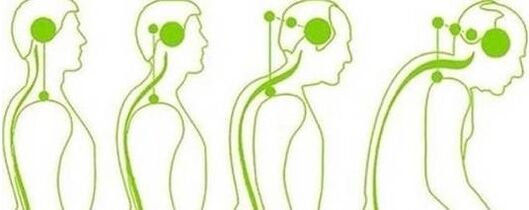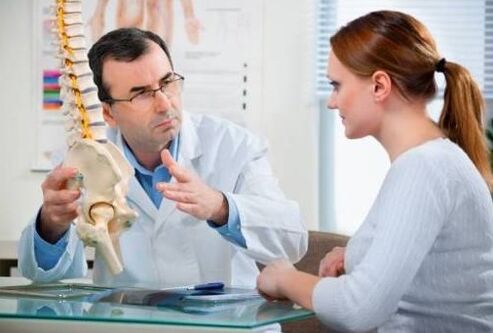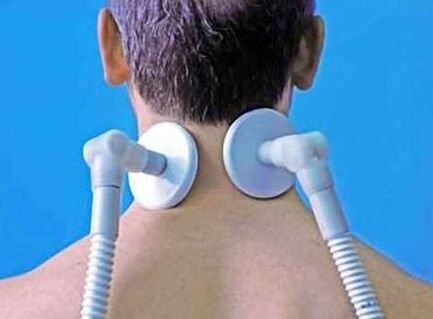Cervical osteochondrosis develops more frequently in adults, but due to certain circumstances, a child may occur. When characteristic signs of this disease appear, you must communicate with a therapist or a narrow profile specialist, a neurologist.

The degenerative-dystophical destruction of the cervical album of the column characterizes cervical osteochondrosis. The gradual progression of the disease leads to the damage to the intervertebral joints, adjacent vertebrae and ligamentary devices. Many mistakenly believe that osteochondrosis is the deposition of salts. However, such a statement is fundamentally incorrect. In fact, salt can be deposited in several joints, but with other pathologies, for example, due to the development of gout.
Thanks to the muscular system, the backbone of the human neck is maintained, which consists of seven vertebrae. In this area, the muscles are poorly developed, due to which, due to long -term tension, fatigue occurs and spasms appear. In the future, the mobility of the cervical vertebrae is limited. As a result of this condition, the column discs are gradually destroyed, which causes the beginning of the first stage of osteochondrosis. In the absence of treatment, the disease constantly progresses, causing all the largest lesions of the spine. To avoid the development of complications, it is necessary to pay attention to the first signs of pathology in time and take appropriate measures.
Most of the time, people like cervical osteochondrosis face people whose lifestyle provides a minimum of physical activity and sedentary work. In such a person, with the greatest probability, the first characteristics can manifest at the age of 25 to 30 years. Among the baby's children to adolescence, the disease is less common, but it can also occur due to an incorrect lifestyle or inheritance, other irritating factors.
Stages of development of pathology and its inherent symptoms
The entire process of developing the osteochondrosis of the cervical column is divided into 4 main stages, each of which is accompanied by certain symptoms. The treatment depends completely on the established gravity of the disease. For example, the first preclinical stage does not require pharmacological treatment. To improve the patient's condition, it is recommended to radically review the lifestyle: perform physical exercises and eat well. The characteristics characteristics of this stage: the excessive tension of the muscles of the entire back, the rapid appearance of a feeling of fatigue, a slight but tangible pain in the moments of the turns and inclinations of the head. The main inconvenience in this case can distinguish the fact that few people give due importance to such symptoms, therefore, they do not immediately resort to the hospital.

The following symptoms are characteristic of second degree osteochondrosis:
- The pain when moving the head becomes more intense and periodically occurs to the shoulders, the hands, even the lower back;
- Pain syndrome can occur in a quiet state;
- There are headaches without cause;
- The attention is dispersed, the level of work capacity is reduced.
All previous symptoms cannot continue to go unnoticed, therefore, for the most part, at this stage of the disease, the patient seeks medical help. Strengthening pain is due to a decrease in the distance between the intervertebral discs and the infraction of the nerves. An even greater aggravation of the situation occurs in the third stage. In this case, the pain in the neck constantly bothers, the muscles of the hands become very weak, from time to time, numbness occurs. As for the general symptoms, dizziness and weakness become the patient's daily companions. The cervical column loses mobility.
Unbearable pain in the neck, shoulders, arms, ears in the ears, complete coordination and the appearance of obvious signs of other diseases indicates the beginning of the fourth final stage of osteochondrosis. At the same time, intervertebral discs are destroyed, and the pathological process moves more along the spine, affecting other departments. Such a degree of disease is difficult to treat, while at the discretion of the doctor, surgical intervention may be needed. Therefore, with the appearance of symptoms such as: neck and crunch pain during head movements, hands, dizziness, nausea, headaches, hands, as well as fatigue and problems with coordination must become an alarming signal that indicates real health problems. Do not delay a visit to the doctor, it is better to contact a therapist or immediately to a neuropathologist.
In the process of progression of cervical osteochondrosis, an infraction of the spine can occur. Different sensitive disorders and motors may appear, depending on the spine, which has suffered:
- Partial or complete loss of sensitivity of the occipital region, anywhere in the neck, shoulders and arms;
- pain in any of the neck areas, shoulders, forearms, hands, to the fingertips;
- numbness of language, so discourse harmed;
- decrease in the muscle tone of the head and neck;
- Problems with respiratory function, heart pain and liver.

The outstanding edges of the vertebrae can squeeze the arteries through which the blood enters the brain. Therefore, blood circulation in the brain is disturbed and additional symptoms appear: a sharp change in mood, insomnia, anxiety without cause, fear, irritability. At the same time, with spasm of blood vessels, not only headache, but also eye pain can occur. Patients often point out the appearance of "flies" in the eyes, sometimes it is possible to pass out.
The reasons for the development of cervical osteochondrosis
The most common cause of the appearance of cervical osteochondrosis is considered a sedentary lifestyle along with inappropriate and unbalanced nutrition. Often, not only lazy people suffer from their nature, but also those whose profession forces most of the time to spend or in the same uncomfortable: office employees, vehicle drivers, etc. Such a way of life causes a constant burden on cervical vertebrae, so muscle spasms arise. The appearance of degenerative processes on the discs is due to a violation of metabolic processes and blood circulation. Other reasons for the development of cervical osteochondrosis include:
- Excess weight caused by unhealthy nutrition;
- rheumatism, scoliosis, posture problems, flat feet;
- column and neck trauma;
- Regular stress, nerve surge;
- hereditary reason;
- Incorrect innate development of cervical vertebrae.
Game Sports Too jealous, which means that too intense physical activity can also become the previous factor in cervical osteochondrosis. Primary disease in such conditions is usually an album. The latter characterizes distributing disorders on intervertebral discs, mainly lumbar and cervical discords. Osteochondrosis in this case is a consequence of an album. In addition to the exclusion of strong physical effort, it is necessary with this diagnosis, complex, drug and physiotherapeutic treatment is necessary.

The consequences of progressive pathology
Among the complications that can occur with the development of the osteochondrosis of the cervical region must be distinguished:
- Hernias and column bump can be formed in the third and fourth stages due to the rapid progression of the underlying disease;
- The growth of bone tissues or the formation of osteophytes are often protuberances herbings. Osteophytes have an irritating effect on the muscles located nearby, which increases their tone. Then, the pressure on the intervertebral discs increases. In addition, educated osteophytes can cause the narrowing of arteries;
- The flattening of the spinal disc: a decrease in the intervertebral hole leads to a decrease in the height between the intervertebral discs, the risk of a subluxation of the cervical vertebrae with a strong turn of the head increases;
- Spondylistz or displacement of the spinal disc does not happen as often as other complications above, however, in case of occurrence, even death can even cause death. Any minimum change in the position of the intervertebral disc with the greatest probability leads to paralysis, a more significant displacement, to death.
Cervical osteochondrosis always causes an increase in blood pressure. In addition, the transition of the underlying disease from one stage to another contributes to the progression of the hypertension from the first to third grade, in which the pressure exceeds the 180 mm mark. Hypertension treatment directly helps reduce the severity of symptoms, but only temporarily. In case of non -cured osteochondrosis, it is impossible to get rid of the increase in blood pressure. In the case of disk damage between cervical vertebrae 4 and 5, as a complication, periartritis occurs. Characterize the pinched nerves located in the connection of the shoulder joint with your hand. At the same time, severe pain occurs on the shoulder, with a negative effect on the mobility of the entire limb. In addition, manifestations of osteochondrosis cannot be based on signs of heart disease, for example, Angina pectotoris, but thanks to diagnostic measures, it is possible to differentiate diseases with high precision.
It is impossible to determine the osteochondrosis of the cervical column by palpation and as a result of a visual medical examination. According to the history collected, the doctor can only assume that precisely osteochondrosis became the cause of certain symptoms. To confirm or refute this assumption, the diagnosis is necessary. The most optimal form today is a tri or magnetic resonance therapy. This method allows you to consider all bone structures, identify the presence of intervertebral hernias, the size of osteophytes and other characteristic complications of cervical osteochondrosis. Another way less informative, is computerized tomography. It allows you to establish a diagnosis, however, the determination of the size of the hernia, since its presence can be difficult.

Cervical osteochondrosis treatment
The treatment of osteochondrosis of the cervical region is always complex and complex. Its duration and saturation depend on the stage of disease development, on the individual's individual characteristics and the presence of other concomitant diseases. Among the main groups of medicines, which are often prescribed in the second and other stages, it must be distinguished:
- Analgesics or analgesics. Listing funds help reduce pain temporarily. With a pain that is too pronounced, the local Novocaine block is used.
- Non -steroidal anti -inflammatory drugs and anti -inflammatory steroidal drugs. Non -steroidal agents are safer, have an analgesic effect and can become an alternative to ordinary analgesics. In the event that they do not relieve pain, steroid drugs are used.
- Antidepressants and sedatives - Motherwort, Valerian tincture. Its purpose is due to two factors: if the cause of osteochondrosis is an excess of nervous straight or if the pain is so serious that it has a negative effect on the psyche. The use of such drugs must be carried out under a strict observation, since each of the drugs has a series of contraindications and is addictive.
- Musorelaxantes that help relieve muscle spasms. In combination with anti -inflammatory drugs, they have an analgesic effect.
- VASRANSDILATORS that contribute to the improvement of blood circulation.
- Medications to increase immunity and normalization of metabolic processes are ideal for vitamins B and C.
The complex of these medications is a symptomatic treatment. The fulfillment of all the recommendations of the doctor and the passage of the prescribed course will help eliminate the pain and get rid of all the unpleasant manifestations of the disease. However, the therapeutic course does not end there. When the main characteristics are eliminated, which worsened the quality of life, it can assume the restoration of the cervical region to minimize the risk of relapse of the disease in the near future. Unfortunately, a great mistake of many people is that after the disappearance of symptoms, they are considered completely healthy and abandon treatment. In this situation, osteochondrosis will certainly remember itself after a while.
Traditional physiotherapy and medicine
The following physiotherapeutic procedures are successfully used to treat cervical osteochondrosis:

- Medical Physical Education: It is carried out exclusively under the supervision of a qualified specialist, since with serious intervertebral discs, incorrect exercises can further damage tissues;
- Manual therapy: It is a manual effect in certain areas of the patient's body;
- therapeutic massage;
- reflexology and, as a variety, acupuncture;
- Electrophoresis, Balneotherapy, Laser therapy, UFOs, etc.
Each of the above procedures has a series of contraindications, which is especially important for those who have an anamnesis of other diseases that are not related to the osteochondrosis of the cervical column. The decision on the suitability of the use of a particular method remains with the treating doctor. It is possible that it is not safe to carry out such measures by its own free will. As for traditional medicine, you can use the herb of a saber fish, saved. Fig. It is also recommended to reduce salt intake. A responsible approach for the treatment of cervical osteochondrosis will allow to get rid of the disease with security. Let this process take a considerable amount of time, but only complex therapy will reduce the possibilities of disease development to a minimum.

























